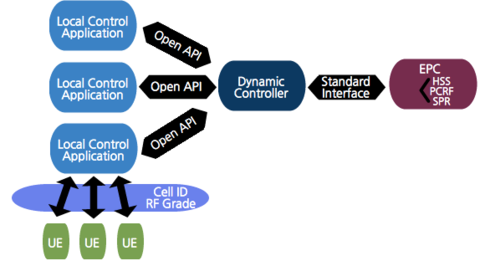Summary
The ability for public safety personnel to have access to local control of users on the network during an emergency is vital to operations. The Public Safety Communications Research (PSCR) program is currently defining the initial requirements for an Application Programing Interface (API) that will enable the creation of a public safety local control application. This application will allow authenticated users to make secure requests to modify priority and Quality of Service (QoS) settings of public safety users using the Public Safety Broadband Network.
Description

Local Control Terminal Concept depicting a high level design.
In March 2012, the National Public-Safety Telecommunications Council (NPSTC) Local Control Task Group published a report titled, “Local Control in the Nationwide Public Safety Broadband Network”. The NPSTC report identified four areas where users will need some type of control in respect to first responder’s use of the nationwide public safety broadband network. The four focus areas identified were: User and Device Management, Network Design, Network Operations and Maintenance, and Applications and Services. PSCR is currently identifying gaps in the current technologies and standards, executing research that can help fill the technical voids, and providing direction to both industry and academic research. CRADA partners currently offer limited dynamic QoS functionality, with no cross functionality between vendors. A single terminal with a standard interface to trigger dynamic QoS policy changes for a single user or groups of users across various EPC solutions would offer a huge benefit to the public safety community.
AN INNOVATIVE APPROACH
PSCR works closely with the public safety user community and the major organizations that represent and advocate on behalf of the community. In conjunction with this collaboration, PSCR uses the following approach:
- Evaluate the four focus areas of the Local Control for technical feasibility
- Identify technical gaps and target areas of research
- Provide insights on the performance trends and trade-offs in order to identify the key factors and configuration parameters that affect performance
- Define an initial set of requirements and guidelines for future development of an API that will enable a Public Safety User Terminal to request dynamic changes in user priority
VALUE TO PUBLIC SAFETY
The 2012 NPSTC report included a focus on technology gaps to identify areas where supplemental research will have the greatest impact. Additional research efforts can add clarity and direction to these focus areas within the larger scope of the Local Control feature. One particular gap identified during the fact gathering and technical feasibility analysis is the creation of a secure API and a Public Safety Local Control Terminal. This would safely allow requests for the dynamic control of QoS policy from outside the EPC. By enabling this technology and setting the groundwork for defining the API, both industry and academia will have a base architecture to use for future designs and research. The implementation of a Public Safety User Terminal will provide a simple, secure, and low cost method to initiate dynamic user priority requests into the more expensive and complicated interfaces of the vendor supplied Dynamic Priority Controllers.

